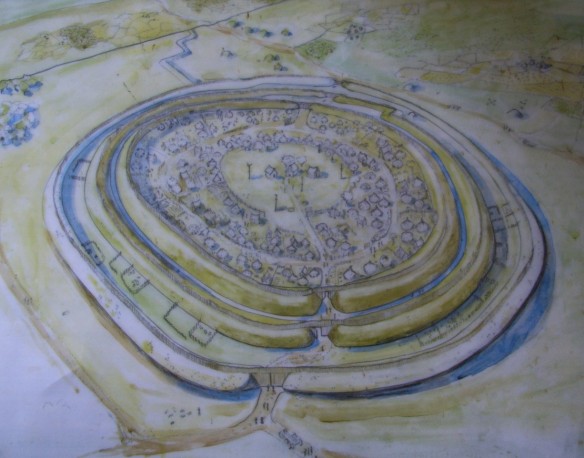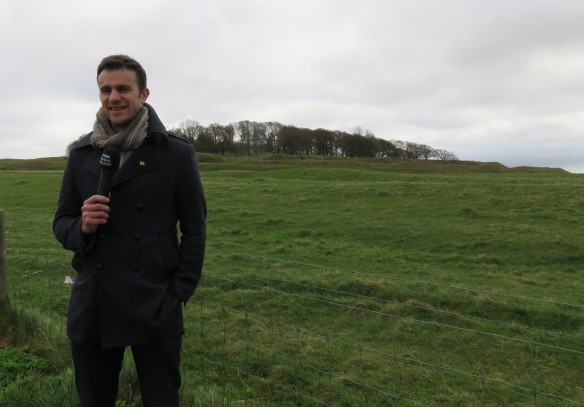I saw it once by moonlight. Returning on the Marlborough Road, in the dark, surrounded by the silver-washed, gently curving chalkland. Then dreaming..forgetting…and a little before the Avebury turning… it reared up from the right, huge and impossible. Surely too big to be made, a conical flat-topped mass. A passing Neolithic shock.

I remembered 1968, my mum calling me to the TV. Live archaeology and Professor Atkinson driving his tunnel to the centre. I had no idea what Silbury was then. I never saw it until I was 18.
Then in the 90s, after moving to Wiltshire, sitting in Devizes Museum at the WAC meeting. At the end, we drank coffee and Gill and Andrew said: ‘yes, we were there with Atkinson.We walked with him to the centre’. Wow! What a thing!
The National Trust have never owned Silbury but have managed it as part of their Avebury Estate.
In May 2000, we were excavating the Lacock Rockworks. Rosie, the Avebury archaeologist ranger, arrived late. She had been called to the top of Silbury with Chris, the NT property manager. ‘There’s a hole!’ she said, ‘a vertical shaft right down to the centre of Silbury’.
English Heritage fenced it off and considered the options. The Hill was not as stable as might be imagined.
For many generations visitors had wondered. Was this the tomb of a great king? Something so huge had surely been raised in honour of someone exceptional and his grave must be furnished with fabulous treasure. So, in 1776, Edward Drax, with some support from Hugh Percy duke of Northumberland, directed a group of miners to sink a vertical shaft to the centre. They were disappointed, no tomb was found. Silbury was further disturbed in 1849, by Rev John Merewether, who organised the digging of a new horizontal tunnel, no finds for him either except his report of preserved organic remains near the centre. Then a pause for a century plus and Professor Atkinson, famed for his work at Stonehenge, directed the campaign I had seen on TV as a child. Another horizontal tunnel with branches.
The experts shook their heads. Something must be done. A conference was called and the players assembled at Devizes Corn Exchange. I sat and heard the debate and remembered Professor Bradley strongly advocating the solution. Reopen Atkinson’s shaft, assemble a crack team and employ the very best archaeological techniques that the 21st century can offer. Create a new exceptional record and then backfill with packed chalk…and seal for all time.
And so it came to pass. The tunnel was opened, the section through the hill was scanned, drawn and photographed in great detail. Samples were taken and analysed…..and then, the invitations went out.

In the autumn of 2007, we assembled at the portacabins for the health and safety talk. David Attenborough, almost 40 years later, had just returned again from the centre… and now it was our turn.
Along a track…Silbury looming over us…we circled the perimeter of the artificial mountain, to arrive at a concrete portal at its base. The worn green door had a futuristic S on the front, not superman.. Silbury of course, and above it on the lintel ..1968.

Jim Leary, the English Heritage site director, gave an introductory talk on the threshold,…then the door was opened and we were allowed to enter. ‘we few, we happy few’.
A line of steel ‘U’ frames ran into the distance illuminated by rigged strip lights a network of wires and ribbed ventilation tubing but amongst it all and between the frames the stratigraphy of the mound. ‘Here is the trampled chalk’ Jim pointed. The ancients had worked here compressing the chalk rubble with their feet as they built their mountain.
Further in and the frames were bent and twisted. The torch illuminated a void sloping upwards. Was this where Professor Atkinson cut Rev Merewether’s tunnel?

Deep below the mound and far from the entrance, the white chalk walls turned brown. We had crossed the inner ditch and here were the beginnings of the construction. Silbury had been built in successive phases but the C14 dates tell us that all the work took place over a short period, c.2400-2300 BC. They started small, heaping gravel from the nearby river and then cutting the turf and topsoil and heaping it into a mound.

We reached the far end and here was the treasure where we stopped. The famous turf stack where the 1960s diggers had told their stories of green grass and beetles’ wings. Extraordinary environmental survival, sealed within the earth. Many more samples were taken and the list of plants and invertebrates grew and told of a landscape of chalkland pasture. Though we do not know the exact year, the insects tell us that this organised and presumably vast community of farmers cut this turf in the summer. Some of the creatures that were found, only emerge from their larvae in August.

They didn’t stop. They kept building. What drove them on? They dug deep into the chalk creating a massive moat that still fills with water after heavy rain in winter. They heaped the chalk higher and higher. A monument to the very end of the Neolithic..as if to say. ‘See! This is what we can do with bone and wood and stone’. That was before the strangers came with their clever rocks from far away. Rocks that could be melted and mixed and beaten to create sharp blades and shiny ornaments.

Nancy and I retraced our steps, back down the tunnel and out into the light. Best to go to the Avebury Henge, to walk beside the megaliths and then to take tea in the Stones restaurant beside the tithe barn.
To savour the electricity of the moment.










